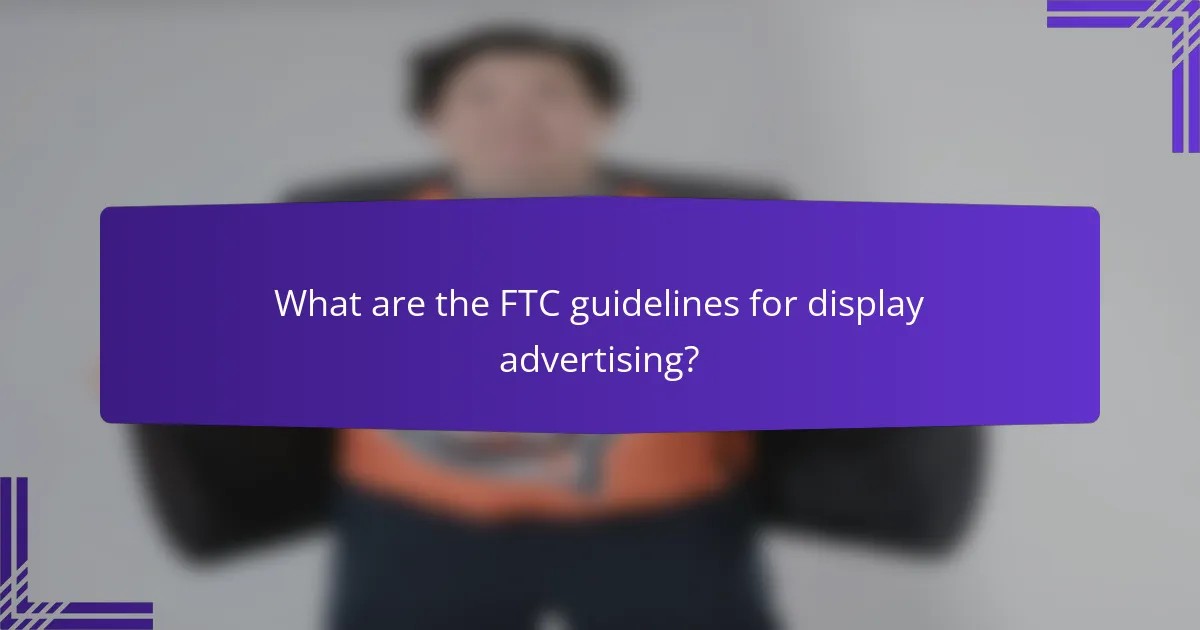The FTC guidelines for display advertising are designed to ensure that advertisements are easily recognizable and not misleading to consumers. By emphasizing transparency and disclosure, these regulations require advertisers to clearly communicate any material connections with endorsers, fostering trust and honesty in advertising practices.

What are the FTC guidelines for display advertising?
The FTC guidelines for display advertising require that advertisements be clearly identifiable as such, ensuring consumers are not misled. These guidelines emphasize the importance of transparency and disclosure in advertising practices to maintain consumer trust.
Disclosure requirements
Disclosure requirements mandate that advertisers must clearly inform consumers when content is sponsored or paid for. This can include using terms like “ad,” “advertisement,” or “sponsored” in a prominent position, ensuring visibility and clarity. For example, a social media influencer should label a post as an advertisement if they receive compensation for promoting a product.
Transparency obligations
Transparency obligations focus on providing consumers with enough information to make informed choices. Advertisers must avoid deceptive practices and ensure that any claims made in advertisements are substantiated. For instance, if a product claims to improve health, the advertiser should have credible evidence to support such claims.
Enforcement actions
The FTC has the authority to take enforcement actions against advertisers who violate these guidelines. This can include fines, penalties, or requiring corrective advertising to address misleading claims. Advertisers should be aware that non-compliance can lead to significant legal repercussions and damage to their reputation.

How do FTC guidelines affect advertisers in the US?
The FTC guidelines significantly influence how advertisers operate in the US by mandating transparency and honesty in advertising practices. These regulations require clear disclosures about material connections between advertisers and endorsers, ensuring consumers are not misled.
Impact on ad campaigns
The FTC guidelines can alter the structure and messaging of ad campaigns. Advertisers must ensure that any endorsements or testimonials are genuine and reflect the typical experience of consumers. This may lead to a shift in strategy, requiring more authentic content that resonates with audiences while adhering to legal standards.
Failure to comply with these guidelines can result in penalties, including fines and mandated changes to advertising practices. Advertisers should be aware that misleading claims or insufficient disclosures can damage their reputation and consumer trust.
Compliance strategies
To align with FTC guidelines, advertisers should implement clear disclosure practices in all campaigns. This includes using straightforward language to inform consumers about any sponsorships or partnerships, ensuring that disclosures are easily noticeable and not buried in fine print.
Regular training for marketing teams on compliance is essential. Advertisers can create checklists to review all materials before publication, ensuring that all endorsements are backed by evidence and that disclosures are present where required. Monitoring and adjusting campaigns based on feedback and regulatory updates can further enhance compliance efforts.

What are the key requirements for transparency in advertising?
The key requirements for transparency in advertising focus on ensuring that consumers are aware of the nature of the content they are engaging with. Advertisers must clearly disclose when content is sponsored or when there are material connections that could influence the message being conveyed.
Clear labeling of sponsored content
Clear labeling of sponsored content is essential to inform consumers that the material is paid for by a brand or organization. This labeling should be prominent and easily noticeable, using terms like “Sponsored,” “Ad,” or “Paid Promotion” at the beginning of the content.
For example, a social media post that promotes a product should include a clear label at the top, ensuring that viewers understand it is an advertisement rather than organic content. This helps maintain trust and credibility with the audience.
Disclosure of material connections
Disclosure of material connections involves informing consumers about any relationships between the advertiser and the endorsers or influencers involved in the promotion. This includes financial ties, gifts, or other incentives that could affect the endorsement’s objectivity.
For instance, if an influencer receives free products or payment for promoting a brand, they must disclose this relationship clearly, often using phrases like “I received this product for free” or “Paid partnership.” Such transparency is crucial for maintaining ethical standards in advertising.

What are the penalties for non-compliance with FTC guidelines?
Penalties for non-compliance with FTC guidelines can include substantial fines, legal actions, and reputational damage. Businesses that fail to adhere to these regulations risk facing significant financial and operational consequences.
Fines and sanctions
The Federal Trade Commission (FTC) can impose fines that vary widely based on the severity of the violation. Fines can range from several thousand to millions of dollars, depending on factors such as the nature of the offense and whether it is a repeat violation. Sanctions may also include mandatory compliance programs or corrective advertising requirements.
For instance, companies found guilty of deceptive advertising practices may face fines that can reach into the low six figures or higher. It is crucial for businesses to stay informed about the specific regulations applicable to their industry to avoid these financial penalties.
Legal repercussions
Non-compliance with FTC guidelines can lead to legal actions, including lawsuits from consumers or competitors. The FTC has the authority to initiate enforcement actions, which can result in court orders requiring businesses to cease certain practices or pay restitution to affected consumers.
Additionally, businesses may face increased scrutiny from regulatory bodies, which can lead to ongoing legal challenges. Companies should implement robust compliance programs to mitigate these risks and ensure adherence to FTC regulations.

How can advertisers ensure compliance with FTC guidelines?
Advertisers can ensure compliance with FTC guidelines by being transparent about their relationships with endorsers and clearly disclosing any material connections. This includes using straightforward language and prominent placement of disclosures to inform consumers effectively.
Best practices for disclosures
To create effective disclosures, advertisers should use clear and unambiguous language that consumers can easily understand. Disclosures should be placed near the endorsement or advertisement, ensuring they are not hidden or overlooked. For instance, using phrases like “Paid partnership” or “Sponsored content” can help clarify the nature of the relationship.
Additionally, consider the format of the disclosure. If using social media, a simple hashtag like #ad or #sponsored can suffice, but it should be placed at the beginning of the post to maximize visibility. Advertisers should avoid jargon and ensure that the disclosure is easily readable on all devices.
Tools for monitoring compliance
Advertisers can utilize various tools to monitor compliance with FTC guidelines effectively. Social media analytics platforms can track engagement and ensure that disclosures are visible and understood by the audience. Tools like Hootsuite or Sprout Social can help manage posts and monitor audience reactions to disclosures.
Regular audits of advertising content can also help identify potential compliance issues. Setting up alerts for specific keywords related to endorsements can ensure that any non-compliant content is addressed promptly. Additionally, consulting with legal experts specializing in advertising law can provide valuable insights into maintaining compliance.

What are the emerging trends in advertising transparency?
Emerging trends in advertising transparency focus on clear communication and ethical practices, driven by consumer demand for honesty. Brands are increasingly adopting transparent strategies to build trust and comply with regulations, particularly in digital advertising and influencer marketing.
Influencer marketing regulations
Influencer marketing regulations are evolving to ensure that endorsements are clearly disclosed to consumers. In many regions, including the United States, influencers must use clear language such as “ad” or “sponsored” to indicate paid partnerships. This transparency helps consumers understand the nature of the content they are engaging with.
Brands should establish guidelines for their influencers to follow, ensuring compliance with these regulations. Regular training sessions and clear contracts can help maintain transparency and protect both the brand and the influencer from potential legal issues.
Consumer expectations for honesty
Consumers today expect brands to be honest and transparent about their advertising practices. This includes clear disclosures about sponsored content, product placements, and any potential conflicts of interest. Meeting these expectations can significantly enhance brand loyalty and consumer trust.
To align with consumer expectations, brands should prioritize authenticity in their messaging and avoid misleading claims. Regularly soliciting feedback from customers can also help brands gauge their transparency efforts and make necessary adjustments to meet evolving consumer standards.

How do FTC guidelines compare to international advertising standards?
FTC guidelines emphasize transparency and disclosure in advertising, aligning with many international advertising standards. However, differences exist in enforcement and specific requirements across various countries, which can impact how businesses operate globally.
BODY REQUIREMENTS
FTC guidelines require clear and conspicuous disclosures for any material connections between advertisers and endorsers. This means that if a product is sponsored or if there are financial ties, these must be disclosed in a way that is easily noticeable to consumers.
In contrast, international standards, such as those set by the European Advertising Standards Alliance (EASA), may have varying requirements. For instance, while the EASA encourages transparency, the specifics of how disclosures should be made can differ significantly from FTC expectations.
DEPTH & COVERAGE
Understanding the depth and coverage of FTC guidelines involves recognizing the need for clear communication in advertising. Advertisers must ensure that their messages are not misleading and that any endorsements are properly labeled. This includes using phrases like “paid partnership” or “advertisement” prominently.
Internationally, the depth of coverage can vary. Some countries may require additional disclosures, such as the nature of the endorsement or the specific benefits received by the endorser. Businesses should familiarize themselves with local regulations to avoid penalties.
ACTIONABLE GUIDANCE
To comply with FTC guidelines, businesses should regularly review their advertising practices. A good rule of thumb is to ask whether a consumer can easily understand the relationship between the advertiser and the endorser. If not, adjustments should be made.
Common pitfalls include vague language or hidden disclosures that consumers might overlook. Advertisers should avoid using fine print or ambiguous terms that could confuse the audience. Instead, opt for straightforward language and prominent placement of disclosures.
